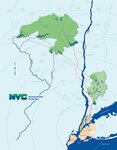GRAHAMSVILLE – If you thought this had been a wet December and January – you were right!
The New York City Water Supply System is completely full thanks to more than 12 inches of …
This item is available in full to subscribers.
Please log in to continue |


GRAHAMSVILLE – If you thought this had been a wet December and January – you were right!
The New York City Water Supply System is completely full thanks to more than 12 inches of precipitation that fell in December and January.
That’s almost twice the normal precipitation of 6 inches and something which the New York City Dept. of Environment Protection (NYCDEP) is monitoring closely.
“It’s good news when you get to a 100 percent capacity on June 1,” NYCDEP Director of Outreach John Milgram said Wednesday. “It is not unusual for the reservoirs to reach 100 percent after a storm system.
“But it is unusual for the entire system to be at 100 percent [of storage] this time of year,” Milgrim said. “It’s extraordinary.”
The total storage of the 19 New York City Dept. of Environmental Proection reservoirs – which feeds more than 1 billion gallons of drinking water to 10 million taps each day – is at 100.5 percent of capacity as of Tuesday.
By way of comparison it would take 2,000 Olympic-sized swimming pools – 50m by 25m by 2m deep – to hold 1 billion gallons.
Historically, the reservoirs have been at 89.4 percent of capacity during January, but due to the increased rain and snowmelt, the system is now at 100.5 percent.
That’s an 11.1 percent increase over normal conditions.
The Neversink Reservoir is spilling, as 34.9 billion gallons of water are behind the earthen dam, filling it to 100.4 percent. The water flows directly into the Neversink River.
The Cannonsville Reservoir – which feeds the West Branch of the Delaware River – is also full to the brim, holding back 95.7 billion gallons of water and is at 102.3 percent of capacity.
And the Pepacton Reservoir – which feeds the East Branch of the Delaware – is at 140.2 billion gallons, which is 100.8 percent of capacity.
“We try and hit our seasonal storage objectives, but they are just targets,” Milgrim said. “In October through March our goal is to be at 90 percent of capacity.
“But when you have more runoff – like we did this year – it will increase,” he said.
Milgram said the reservoirs in the Delaware system are Cannonsville, Pepacton, Neversink and Rondout.
The first three reservoirs all feed into the Delaware River while the Rondout is a terminal reservoir which is fed using underground tunnels from the other three reservoirs and then feeds New York City through the Delaware Aqueduct.
Milgrim said the reservoirs were not built to prevent flooding along the main stem of the Delaware, but by their very natural hold back a lot of water and can be used for additional flood attenuation (reduction).
Milgrim said if the reservoirs were below their 100 percent capacity and the region received a big storm, natural flood attenuation would occur.
Delaware River Keeper Maya van Rossum said she was aware of the full reservoirs.
“We are just monitoring the situation now,” she said. “We are really not concerned about it. Our biggest concern is that it is communicated to the public.”
Comments
No comments on this item Please log in to comment by clicking here